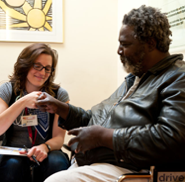Glide Health resembles other community-based health centers, she told me, “except the leadership is a nurse – typically a nurse practitioner -- instead of a physician or other health professional.”
The more important difference, though, is Glide’s “nursing model” approach, which contrasts with the “medical model” that governs most clinics, said Dennehy, who is also a clinical professor in the school of nursing at UCSF.
“The nursing model puts the person in the center instead of the disease,” Dennehy said. “In the nurse-led model, the patient is more than, say, a diabetic. It’s about all the social determinants of your health. Are you a victim of trauma? Depressed? We take time to get to know you. It’s less prescriptive and more of a partnership.”
Nurse-led centers developed out of “the service mission of schools of nursing,” she said. “The faculty wanted to provide service and educate their students.” The National Nursing Centers Consortium lists 128 nurse-led center members across the country, and more than 85 schools of nursing run such clinics, which function as training centers as well.
In many cases, it’s a “marriage between the school, the community and a community hospital,” said Dennehy. “That’s not unusual and it’s the perfect triangle.”
The clinics may be nurse-run, but that doesn’t mean there isn’t a doctor in the house. Many of the clinics recruit doctors to come in on appointed days as part of their professional team. “We have a wonderful internist, a psychiatrist and a pharmacist for parts of the week,” she said.
How does all this play with patients? Is there a lot of explaining to do when a doctor is not around? “If any patient wants to see a doctor, we give them a referral to our doctor or to another place,” said Dennehy. “It doesn’t happen with great frequency, but it does happen.”
The clinic’s bottom line, she said, is that “We think that everyone has the right to choose their care. We’ll do everything we can to help you find another place.”
Is there new momentum for more nurse-led clinics because of the Affordable Care Act?
“It’s very clear that we cannot doctor-up to meet the country’s primary care needs,” said Dennehy.
People are searching for different models, she said, particularly when the ACA is bringing so many new people into full insurance coverage.
Many more medical professionals will have to practice “at the full scope of their competency and their training,” she said.
So what about nurse-led clinics’ prospects?
“There are plenty of new buds on the vine that are trying to get up and going,” Dennehy said. “I think there are going to be more.”
